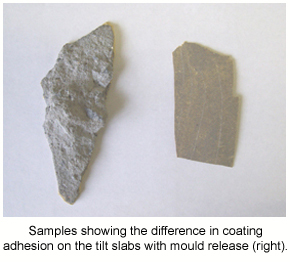Home › Advice › Know How › Knowhow
Concrete Additives and Floor Coating Adhesion
Like most people I suspect, there was a time when I thought concrete was just concrete and all slabs were the same. How wrong I was!
With a little more experience under my belt, I know how flawed this thinking is; in fact, I would now go as far as to say that NO two
concrete slabs are exactly the same. It might sound like a big statement, but when you consider all the variables of modern concreting
practices, it’s quite possible that even the same batch can end up looking and performing differently if applied in two separate
locations.
Concrete slabs aren’t concrete slabs!
Why is this so? When you talk about different locations, you’re also talking about the potential for different weather (temperature,
humidity, wind, sunlight), different handling, different application, different finishing etc. All of these factors can have a big say in
characteristics of a concrete slab, and we haven’t even touched on the content of the concrete itself. Water and the aggregate
composition are obvious variables here, but concrete has come a long way and these days all sorts of concrete additives can be used to speed
up, slow down, harden and even slow corrosion depending on job demands. Imagining every slab as at least slightly different perhaps
doesn’t seem so absurd after all!
Ok, concrete is ever-changing and unpredictable, so what? Well, for coating contractors it can actually be a bit of a problem because it challenges the age-old assumption that sticking to concrete is a sure thing. Some modifications can indeed interfere with coating adhesion, and it was something I learnt the hard way several years ago.
The concrete additives lesson
The painful, yet extremely valuable lesson came through on a project involving a tilt slab construction coated with epoxy for protection and
waterproofing.
For those unfamiliar with tilt slabs, these are slabs that are poured horizontally in moulds then cracked and erected to form the walls of whatever building is being constructed. A “mould release” is used to make it easier for concrete to break away and is generally added in controlled amounts to the moulds themselves and in between the concrete layers.
On this particular project however, there was a rush on the high-profile job (which happens more often than not these days) and the construction company needed the slabs to cure quicker. Conventional concrete accelerators were ruled out because the slabs were being poured on top of each other, so they figured the next best thing was to use greater quantities of mould release to allow successive pours to be done sooner.
Unfortunately, as it was later discovered, the excess mould release was absorbed by the slabs as they cured - not a problem if the panels were left as is, but a major snag when you plan to put a coating on them!
Because of the extreme levels of mould release used, the normal tilt wash detergents were no longer effective. They seemed to be doing their
job on the surface, however the stuff that had soaked into the concrete was playing havoc with coating adhesion. After some desperate
scrambling and frantic tensile adhesion tests, the solution ended up being multiple washes with the detergent and a deep grind to remove
several millimetres of contaminated concrete before coating adhesion was restored. It was an intense experience and a huge sigh of relief
was breathed by all I can tell you!

Be wary of concrete assumptions
I think the take-home message from this near disaster is you need to be wary of all concrete slabs, not just tilt slabs. Every slab is
different, and you need to ask questions of what you see before you rather than make assumptions. What is the composition of the slab? What
else may have been added? What could it have been exposed to?
A similar scenario to the one above that I know catches many people out happens in residential garages. Instead of mould release, the
contaminants in this case are the tyre shine products that are usually a type of silicon spray. Being invisible to the naked eye, it’s
very easy to assume the concrete is clean and washing isn’t necessary. They give the floor a light grind and think it’s all gone
well; only to watch in dismay a short time later as their beautiful new garage floor quickly peels off (read the post here on hot
tyre pick-up).
-
Learning - Learn more about the challenges of preparing concrete for good coating adhesion with our online courses:
- Epoxy Flooring Short Courses
- Bronze Card Course
- Silver Card Course
-
Ask a question - If you have any questions you'd like to ask us about this topic, hit the support button below:
_800x271a.png)
